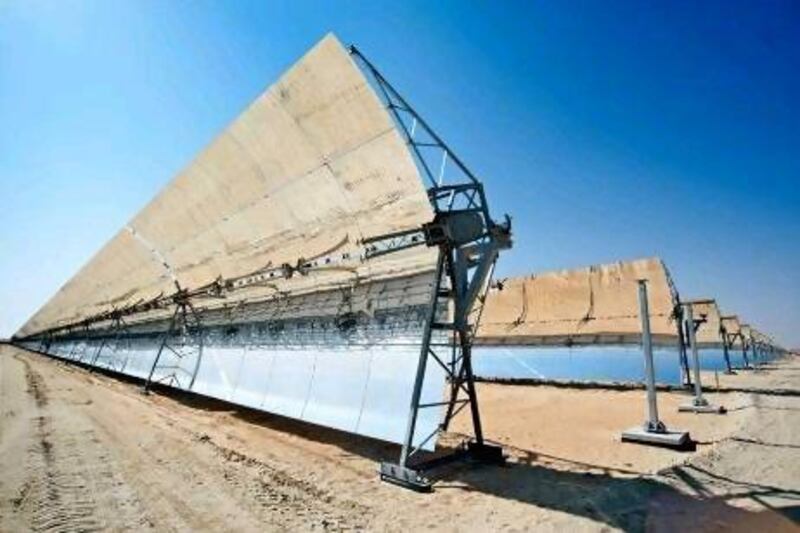ABU DHABI // Turning high, rolling sand dunes into a site for the world’s largest concentrated solar-power plant meant digging and redistributing some 5 million cubic metres of sand.
That is about twice the volume of the Pyramid of Cheops in Egypt.
But the preparatory work that started in June 2010 was only the first of many challenges for the team working on the Shams 1 power plant taking shape near Madinat Zayed, in Abu Dhabi’s Western Region.
When completed this year, the plant will be able to generate 100 megawatts of electricity, enough to power 20,000 homes.
Large enough to accommodate 285 football fields, the site is covered with a giant solar field – row upon row of six metre-tall metal frames with curved glass mirrors attached.
From there it is relatively simple physics: the shape means all of the sunlight hitting the mirrors is reflected on to a small glass tube above the mirrors.
The concentrated sunlight – and this is the stage that gives the process its name “concentrated solar power” – heats up the collector tube and starts a process essential to the production of electricity.
Arranging the mirrors so they do the job was far from simple, said Laurent Longuet, the project manager.
“You need to be accurate and you need to be accurate each time,” Mr Longuet said at a tour of the facility on Wednesday.
The field contains 258,048 mirrors and the plant is 80 per cent complete, with testing of the equipment expected to start soon.
Once it starts operating at the end of the year it will be Abu Dhabi’s largest solar project to date.
Masdar, the capital’s clean-energy company, is building the plant in collaboration with Abengoa Solar, a Spanish infrastructure and environment company, and the French oil company Total.
It is part of Plan Abu Dhabi 2030, which aims reduce the country’s dependence on oil.
Each mirror in the array is attached to the metal frame at four points, and requires precision to obtain the desired effect.
If a mirror is out of place, it will concentrate the sunlight away from the collector tube.
Located on the verge of the Empty Quarter, the site of the power plant is a difficult place to work.
On windy days, such as Wednesday, venturing outdoors without a face mask is difficult because of the large amounts of suspended dust.
The dust is also a challenge for the workings of the plant, as it blocks sunlight and coats the mirrors.
The problem was considered at the time the facility was planned, said Yousif Al Ali, the plant’s general manager.
If the facility were at a proposed site near Al Ain, dust would have been less of an issue, Mr Al Ali said.
But more frequent cleaning – once every five days in the windy season – lifted operating costs only slightly above what they would be at the Al Ain site, he said.
And the Madinat Zayed location is close to a highway, and near an electric-power substation, meaning it will require less infrastructure to be built than the Al Ain site would have needed.
The mirrors will be cleaned by vehicles releasing jets of high-pressure water. To further protect it from the dust, the solar field is also surrounded by a seven-metre wall.





